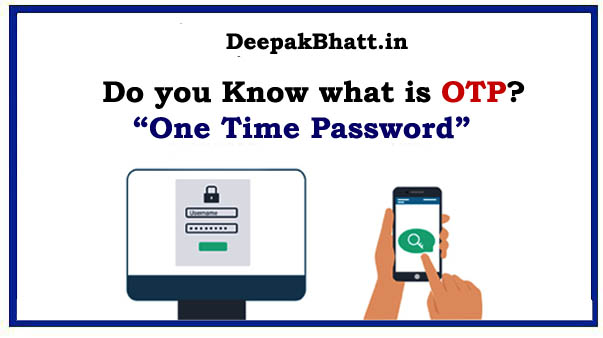What is OTP: OTP means One Time Password. Which is also known as One Time Pin.
This is the password for a computer or digital device that can be used only once. OTP is a 4 or 6-digit security code. Which is sent as an SMS to your registered mobile number.
If you make any online payment. So to complete that transaction, you get an SMS on the registered mobile number. Which is called OTP (One Time Password).
The payment is done only after filling it there. You must have often noted while making the payment. That without entering OTP your payment cannot be completed. Even if you enter the wrong OTP, your payment is not done.
Apart from this, if you log in to any website like Google Pay, Phone Pay, etc. Even then OTP comes on your Registered Mobile Number. Only after filling which you are able to log in. OTP is used only once.
What is OTP?
An OTP, or One-Time Password, is a single-use code generated for authentication purposes. Unlike traditional static passwords that remain constant, OTPs provide dynamic and time-sensitive codes that expire after a short duration, typically a few minutes.
The essence of OTP lies in its ability to enhance security by requiring users to input a constantly changing code along with their regular credentials.
How OTP Works
The fundamental working principle of OTP involves the generation of a unique code that is valid for a brief period. The common methods of generating OTPs include:
1. Time-Based OTPs:
Time-based OTPs are generated using a mathematical algorithm that takes the current time as an input.
The server and the user’s device are synchronized, ensuring that both generate the same OTP at any given moment.
Popular algorithms for time-based OTPs include HMAC-based One-Time Password (HOTP) and Time-based One-Time Password (TOTP).
2. Event-Based OTPs:
Event-based OTPs are generated in response to specific events, such as a user initiating a login request.
Each event triggers the creation of a new OTP. Similar to time-based OTPs, event-based OTPs are single-use and time-sensitive.
3. SMS-Based OTPs:
In this method, the OTP is sent to the user via Short Message Service (SMS). The user receives the code on their registered mobile number and enters it during the authentication process.
While widely used, SMS-based OTPs are considered less secure due to the risk of interception.
4. Email-Based OTPs:
Similar to SMS-based OTPs, email-based OTPs involve sending the code to the user’s registered email address.
The user retrieves the OTP from their email and uses it for authentication. Email-based OTPs, like SMS-based ones, may be susceptible to interception.
5. App-Based OTPs:
Mobile applications, such as authenticator apps, generate OTPs directly on the user’s device.
These apps are often linked to the user’s account and provide a secure way to generate and input OTPs without relying on external communication channels.
Types of OTP
Various types of OTPs are employed in different scenarios to cater to specific security requirements. Some common types include:
1. TOTP (Time-Based OTP):
TOTP generates OTPs based on the current time and a shared secret between the server and the user’s device. The time-based nature of TOTP ensures that the generated codes are valid only for a short period, usually 30 seconds to a few minutes.
2. HOTP (Event-Based OTP):
HOTP relies on a counter value that increments with each authentication event. The server and the user’s device share a secret, and the OTP is generated based on the current counter value. Each successful authentication advances the counter.
3. Biometric OTP:
Biometric OTPs combine traditional OTP methods with biometric authentication, adding an extra layer of security. Users may need to provide a fingerprint, facial recognition, or other biometric data along with the OTP for authentication.
4. PIN-Based OTP:
PIN-based OTPs involve generating a code based on a user-entered Personal Identification Number (PIN). The combination of the PIN and the OTP enhances security by requiring both elements for authentication.
Applications of OTP
OTP finds widespread applications across various domains, contributing to enhanced security and protection against unauthorized access:
1. Online Banking:
OTPs are commonly used in online banking for secure login, transaction authorization, and other sensitive operations. Users receive OTPs on their registered mobile devices or via SMS to validate their identity.
2. Two-Factor Authentication (2FA):
OTPs play a central role in Two-Factor Authentication, where users need to provide two forms of identification for access. Alongside a traditional password, users enter a dynamically generated OTP for an additional layer of security.
3. E-commerce Transactions:
E-commerce platforms often employ OTPs to secure online transactions. Users receive OTPs to confirm purchases, ensuring that only authorized individuals can complete transactions.
4. Email and Social Media Accounts:
To safeguard email and social media accounts, OTPs are used during the login process or when making changes to account settings. This adds an extra layer of verification beyond the static password.
5. Access to Corporate Networks:
Organizations use OTPs to secure access to their corporate networks. Employees may need to provide a time-sensitive OTP in addition to their regular credentials for secure authentication.
6. VPN (Virtual Private Network) Access:
VPNs enhance security for remote access to networks. OTPs are often required along with a username and password to ensure secure connections and protect sensitive data.
7. Government Services:
Government agencies may implement OTPs to secure access to citizens’ online accounts, especially for services involving sensitive information or transactions.
The Role of OTP in Cybersecurity
In the ever-evolving landscape of cybersecurity, OTPs stand as a crucial defense against various threats:
1. Phishing Protection:
OTPs add an extra layer of protection against phishing attacks. Even if a user unknowingly provides their password to a phishing site, the attacker would still need the OTP to gain access.
2. Mitigating Credential Theft:
Traditional static passwords are susceptible to theft through various means. OTPs, especially time-based ones, provide a dynamic and constantly changing element that makes it challenging for attackers to use stolen credentials.
3. Securing Remote Access:
With the rise of remote work, securing remote access to corporate networks is paramount.
OTPs enhance security by ensuring that individuals attempting to access the network are in possession of both static credentials and a dynamic OTP.
4. Reducing the Impact of Data Breaches:
In the event of a data breach where user credentials are compromised, the inclusion of OTPs mitigates the impact. Even with stolen passwords, attackers would need the time-sensitive OTP for successful authentication.
5. Enhancing Multi-Layered Security:
OTPs are a key component of multi-layered security strategies. Combining static passwords, biometrics, and dynamically generated OTPs creates a robust defense against a variety of cyber threats.
Challenges and Considerations in OTP Usage
While OTPs significantly bolster security, there are challenges and considerations associated with their usage:
1. Reliability of Communication Channels:
The reliability of communication channels, such as SMS or email, can impact the delivery of OTPs. Delays or interruptions in these channels may hinder the authentication process.
2. User Experience:
Some users find the process of receiving and entering OTPs cumbersome. Balancing security with a seamless user experience is essential to encourage widespread adoption.
3. Security of OTP Generation:
The security of OTPs relies on the robustness of the generation process. If the algorithm or secret key is compromised, it could undermine the effectiveness of OTP-based security.
4. Potential for Interception:
While time-based and event-based OTPs are generally secure, SMS and email-based OTPs may be susceptible to interception by attackers.
This highlights the importance of using secure communication channels.
5. Backup and Recovery:
In cases where users lose access to their primary devices (e.g., a lost or broken phone), providing secure backup and recovery mechanisms for OTPs is crucial to prevent lockout scenarios.
Free Course:
Learn Digital Marketing Fundamentals
Learn Leads Generator Using Digital Marketing
Future Trends in OTP Technology
As technology advances, several trends are shaping the future of OTP technology and its role in cybersecurity:
1. Biometric Integration:
The integration of biometric data with OTPs is likely to increase, providing an additional layer of security.
Biometric authentication, coupled with dynamically generated OTPs, enhances the overall robustness of access control systems.
2. Hardware Tokens and Security Keys:
Hardware tokens and security keys offer an alternative to mobile-based OTP generators. These physical devices provide an extra layer of security by ensuring that the OTP generation occurs on a dedicated, secure device.
3. Continuous Authentication:
Continuous authentication, where a user’s identity is verified continuously during a session, may become more prevalent. This approach enhances security by continually reassessing the user’s identity beyond the initial login.
4. Machine Learning for Threat Detection:
Machine learning algorithms are increasingly being used to detect patterns indicative of cyber threats. Applying machine learning to OTP authentication systems can improve threat detection and response capabilities.
How is OTP generated?
Algorithms are used to generate OTP. It uses two inputs. The first is Seed and the second is Static Value. which never changes.
It is generated at that time. When a new account is created. Apart from this, the moving factor varies. That’s why we get a new OTP every time.
In this, OTP is valid for a short period on the basis of time synchronization between the Authenticator Server and Client.
A new password is generated based on the mathematical algorithm.
Why OTP is used?
OTP password is more secure than a normal password. A normal Password is created by the user himself to secure his account.
Any hacker can break the normal password in no time. That’s why all online service companies use OTP passwords. By which your account remains completely safe.
This OTP is set by the service provider company to you either through an OTP message or by voice call or on your mail.
Due to this, it becomes clear to the company. That user is an Authorized User. With this, the user’s account is completely safe.
Do not share OTP with anyone
You must have received a message. That’s what you mean by your Don’t Share Your OTP With Anyone. That you do not share your OTP with anyone.
OTP usually works as Two Step Authentication. Which plays an important role in preventing the theft of money from your bank account through online transactions.
If your debit card or credit card is lost somewhere, and if someone tries to do the online transaction with him then he will need OTP and OTP always comes on your registered mobile number only. In such a situation, it may be that someone asks you for OTP, but you should not share OTP with anyone.
Conclusion
In conclusion, OTPs stand as a stalwart guardian in the realm of cybersecurity—an essential tool for protecting sensitive information and ensuring secure access to digital services.
As the digital landscape continues to evolve, the role of OTPs remains pivotal in the ongoing battle against cyber threats.
Understanding the mechanisms, types, applications, and challenges of OTPs empowers individuals and organizations to navigate the digital world with heightened security and confidence.
You May Also Like:
What is DSLR Camera? Features & work
What is a Payment Gateway
What is Google Firebase
आप सभी का मेरी वेबसाइट पर स्वागत है। मैं Blogging, earning money online और अन्य Categories से संबंधित Post Updates करता रहता हूँ। यहाँ आपको बहुत अच्छी Post पढ़ने को मिलेंगी। जहाँ से आप बहुत सारा Knowladge बढ़ा सकते हैं। आप हमारी website और Social Media के माध्यम से हमसे जुड़ सकते हैं। धन्यवाद







